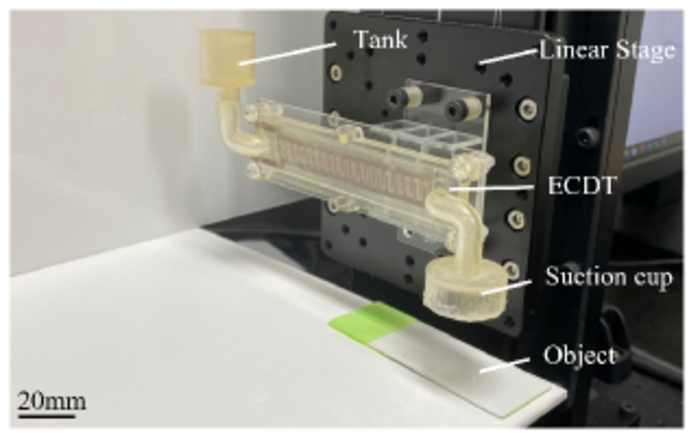The word “robot” would probably conjure up images of hard metallic bodies that are invulnerable to attacks. In modern day-to-day life, however, robots are hardly needed for defending against enemy attacks. Instead, they are required to perform more mundane tasks such as handling delicate objects and interacting with humans. Unfortunately, conventional robots perform poorly at such seemingly simple tasks. Moreover, they’re heavy and often noisy.

Credit: Shingo Maeda from Shibaura Institute of Technology, Japan
The word “robot” would probably conjure up images of hard metallic bodies that are invulnerable to attacks. In modern day-to-day life, however, robots are hardly needed for defending against enemy attacks. Instead, they are required to perform more mundane tasks such as handling delicate objects and interacting with humans. Unfortunately, conventional robots perform poorly at such seemingly simple tasks. Moreover, they’re heavy and often noisy.
This is where “soft” robots have the upper hand. Made of materials called “elastomers” (materials with high viscosity and elasticity), soft robots absorb shocks better, can adapt better to their environments, and are safer compared to conventional robots. This has allowed for a broad range of applications, including medicine and surgery, manipulation, and wearable technology. However, many of these soft robots rely on fluidic systems, which still use pumps operated by mechanical parts (motors and bearings). As a result, they are still heavy and noisy.
One way around this problem is to use chemical reactions to drive pumps. But while such systems are definitely lightweight and quiet, they don’t perform as well as conventional pumps. Is there a way to beat this trade-off? Turns out, the answer is yes. A team of researchers from Shibaura Institute of Technology (SIT), Japan, led by Prof. Shingo Maeda, introduced an “electrohydrodynamic” (EHD) pump that uses electrochemical reactions to drive pumps. The EHD pumps have all the advantages of pumps driven by chemical reactions and none of their issues.
Now, in a recent study, the team, including Prof. Maeda, Yu Kawajima, Dr. Yuhei Yamada (all from the Department of Engineering Science and Mechanics, SIT), and Associate Professor Hiroki Shigemune (Department of Electrical Engineering, SIT) has gone one step further, designing a “self-sensing” EHD pump that uses an electrochemical dual transducer (ECDT) to sense the fluid flow, which, in turn, activates electrochemical reactions and increases current. “Self-sensing technology has attracted much attention recently for compactifying soft robots. Incorporating sensors in soft robots enhances their multifunctionality, but often make for complex wiring and bloating. Self-sensing actuation technology can help solve this issue and allow for miniaturization of soft robots,” explains Prof. Maeda. This paper was made available online on 7 January 2022 and was published in Volume 14 Issue 2 of the journal ACS Applied Materials & Interfaces on 19 January 2022.
The team based the ECDT design on the EHD pump they had previously designed. The pump consisted of a symmetrical arrangement of planar electrodes, which allowed an easy control of the flow direction by simply changing the voltage. Moreover, the arrangement enabled an obstruction-free flow and in the same amount in each direction owing to same strength of the electric field on either side.
The team evaluated sensing performance in terms of range of detectable flow, rate, sensitivity, response, and relaxation times, and also used mathematical modeling to understand the sensing mechanism. “The ECDT can easily be integrated into a fluidic system without bloating or complexity,” says Yu Kuwajima, doctoral student at the Smart Materials Laboratory (SIT) and the first author of the study. Additionally, the researchers tested its performance by using it to drive a suction cup to detect, grab, and release objects.
“The advantages of the ECDT are that it does not require any special equipment or complex processing for its fabrication. Moreover, it is small, lightweight, and demonstrates a wide range of sensitivity,” says Prof. Maeda.
However, the ECDT is more than just about soft robot miniaturization. It is a step towards a future in which humans and robots would not simply co-exist but their interaction would become fluid and natural. An exciting prospect to entertain, for sure!
***
Reference
DOI: https://doi.org/10.1021/acsami.1c21076
About Shibaura Institute of Technology (SIT), Japan
Shibaura Institute of Technology (SIT) is a private university with campuses in Tokyo and Saitama. Since the establishment of its predecessor, Tokyo Higher School of Industry and Commerce, in 1927, it has maintained “learning through practice” as its philosophy in the education of engineers. SIT was the only private science and engineering university selected for the Top Global University Project sponsored by the Ministry of Education, Culture, Sports, Science and Technology and will receive support from the ministry for 10 years starting from the 2014 academic year. Its motto, “Nurturing engineers who learn from society and contribute to society,” reflects its mission of fostering scientists and engineers who can contribute to the sustainable growth of the world by exposing their over 8,000 students to culturally diverse environments, where they learn to cope, collaborate, and relate with fellow students from around the world.
Website: https://www.shibaura-it.ac.jp/en/
About Yu Kuwajima from SIT, Japan
Yu Kuwajima is a doctoral student at the Smart Materials Laboratory at Shibaura Institute of Technology (SIT), Japan. He is interested in new mechanism for soft machines.
About Professor Shingo Maeda from SIT, Japan
Shingo Maeda is a Professor at the Department of Engineering Science and Mechanics at Shibaura Institute of Technology (SIT), Japan. He currently runs the Smart Materials Laboratory at SIT, which aims to create “soft” mechanical systems, such as soft robots. For more details, please visit: http://www.intmat.meo.shibaura-it.ac.jp/wp/
DOI
10.1021/acsami.1c21076
Method of Research
Experimental study
Subject of Research
Not applicable
Article Title
Electrochemical Dual Transducer for Fluidic Self-Sensing Actuation
Article Publication Date
19-Jan-2022
COI Statement
The authors declare no competing financial interest.




